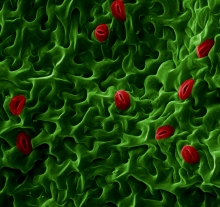
A Solvathon at the Bieler School of Environment, McGill University
Keynote speakers: Kim Stanley Robinson and Annalee Newitz
October 12-13, 2023

A Solvathon at the Bieler School of Environment, McGill University
Keynote speakers: Kim Stanley Robinson and Annalee Newitz
October 12-13, 2023

Two McGill University astronomers have assembled a “fingerprint” for Earth, which could be used to identify a planet beyond our Solar System capable of supporting life.

If parts of the neutron star interior start to move outwards, the star spins faster. This is called a “glitch,” and it’s providing astronomers with a brief insight into what lies within these mysterious objects.

The discovery of the mechanics and molecular mechanism that dictate cell shape formation in plants by a team of McGill researchers offers new clues about the fundamental processes governing tissue formation in multicellular organisms.
Plants are made of cells that come in a wide array of shapes and sizes, each of which is closely related and essential to the function of a specific tissue.

The discovery of fossilized plants in Labrador, Canada, by a team of McGill directed paleontologists provides the first quantitative estimate of the area’s climate during the Cretaceous period, a time when the earth was dominated by dinosaurs. The specimens were found in the Redmond no.1 mine, in a remote area of Labrador near Schefferville, in August 2018. Together with specimens collected in previous expeditions, they are now at the core of a recent study published in Palaeontology.

In conjunction with a $35 million research funding announcement to support 128 researchers through the Natural Sciences and Engineering Research Council of Canada’s (NSERC) Discovery Grants program, Canada’s Minister of Science and Sport, Kirsty Duncan, was on campus today to sign the Dimensions Charter.

The Chan Zuckerberg Initiative (CZI), The Leona M. and Harry B. Helmsley Charitable Trust, and the Klarman Family Foundation today announced $468,860 in collaborative funding to support ethical biomedical research and responsible data sharing for the Human Cell Atlas (HCA), an international effort to map all cells in the human body. The Centre of Genomics and Policy (CGP) at McGill University will help guide and inform the approach and governance of data sharing to assist participating investigators to collect and share data.


Scientists at the University of Montreal and McGill University have pioneered and tested a new genomic methodology which reveals a complex bacterial ecosystem at work on the International Space Station.
Until now, relatively little was known about the different types of microbes found on the space station. The new approach enables researchers to identify and map different species inside the ISS, which will ultimately help safeguard astronauts’ health and be key to future long-term space travel.

Rapid changes in terrain are taking place in Canada’s high Arctic polar deserts due to increases in summer air temperatures.

Elwyn was a healthy 13 month-old toddler when she started drinking water from the bathtub. Over time, she became increasingly thirsty and demanded more and more breast milk. For her parents, this seemed like typical behaviour related to a growth spurt. One day, however, they noticed that she was abnormally weak and rushed her to the emergency department. She was diagnosed with type 1 diabetes and had already developed a life-threatening complication of the disease known as diabetic ketoacidosis.

By Meaghan Thurston
On May 3, the Natural Sciences and Engineering Research Council (NSERC) announced the recent recipients of the NSERC Strategic Partnership Grants program. Six McGill-led projects in the Faculty of Engineering and one in the Faculty of Medicine are receiving more than $3.7 million to conduct research in collaboration with a supporting organization.
Some students at McGill University are taking the idea of “mind over matter” to a whole new level: they’ve developed a wheelchair that moves using your imagination.
Thirty five McGill students came together on their own time and designed “Milo” in just 30 days.
“Milo is a brain-controlled wheelchair that relies on imagined movement to turn. So when you imagine turning your right hand you can turn right and when you imagine turning your left hand you can turn left,” explained Danielle Nadin, who worked on data collection.

The Event Horizon Telescope (EHT) — a planet-scale array of eight ground-based radio telescopes forged through international collaboration — was designed to capture images of a black hole. Today, in coordinated press conferences across the globe, EHT researchers reveal that they have succeeded, unveiling the first direct visual evidence of a supermassive black hole and its shadow.